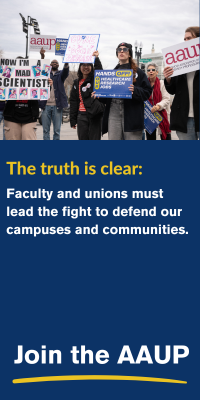- About
- Programs
- Issues
- Academic Freedom
- Political Attacks on Higher Education
- Resources on Collective Bargaining
- Shared Governance
- Campus Protests
- Faculty Compensation
- Racial Justice
- Diversity in Higher Ed
- Financial Crisis
- Privatization and OPMs
- Contingent Faculty Positions
- Tenure
- Workplace Issues
- Gender and Sexuality in Higher Ed
- Targeted Harassment
- Intellectual Property & Copyright
- Civility
- The Family and Medical Leave Act
- Pregnancy in the Academy
- Publications
- Data
- News
- Membership
- Chapters
From the Editor: Loose Talk Of Tulips
Academe Editor Cat Warren's Column
There you go again, Ronald Reagan’s education secretary, William Bennett, scathingly told universities in a 1987 New York Times column, “Our Greedy Colleges.” Students don’t deserve tax support. “On average, college graduates earn $640,000 more over their lifetimes than non-graduates do. It is simply not fair to ask taxpayers, many of whom do not go to college, to pay more than their fair share of the tuition burden.”
Now, a quarter of a century later, we are reaching the nadir of the Great Dismantling started by Reagan’s folksy notion that public investment and public institutions are the problem. Now, higher education is at the center of the problem. The libertarian literati talking point that launched in 2008 is that higher education is a less colorful version of tulips in the Dutch golden age—a speculative bubble that deserves to be popped. No more talk of lifetime salary achievement.
GOP presidential candidates like Rick Perry are not only deriding the need for research universities and tenured faculty but pushing for the extinction of federal student loans for higher education. It’s not an outlier position: “It’s an absurdity,” declared Newt Gingrich. “We should get rid of the loan programs,” said Ron Paul.
Effective sound bites often have a nub that people can easily sink their teeth into. Student loan debt is approaching $1 trillion. Tuition is skyrocketing. Protesters at various Occupy demonstrations are noting their inability to pay those college loans, now averaging $25,000 per graduated borrower. Americans owe more on student loans than on their credit cards. Though it is a disaster that only will get worse under the “reforms” and state and federal funding cutbacks being proposed, it’s not a bubble.
Nonetheless, conservatives are having a field day with the self-fulfilling disaster they helped to sow, even using the various Occupy movements in their arguments. Those jobless college graduates are out there because their degrees provided them with nothing but the desire to be part of a useless, baseless social movement, proof positive that nothing good comes of a higher education. One headline for a conservative think tank reads: “Occupy Wall Street might never have started if politicians hadn’t oversold higher education.”
Billionaire hedge fund manager and libertarian Peter Thiel—one of the biggest blowers of the loose bubble talk—has also floated a project tantamount to a small, rigged lottery. He has persuaded mostly elite students from universities like Harvard, Stanford, Yale, and the Massachusetts Institute of Technology to drop out for $100,000 in start-up money. What will this ultimately prove? It’s unlikely that twenty smart, mostly privileged students under the age of twenty would lose all their entrepreneurial smarts and privileges by sticking around a couple of extra years at a top university.
The truth is that dropouts rarely prosper, not even in Horatio Alger’s novels. Currently, the rate of unemployment among college graduates is less than half that of workers with a high school diploma.
What is true is that student debt has skyrocketed in the past decade, amounting to what one author in this issue of Academe, Jeffrey Williams, terms “indentured servitude.” The solution, though, isn’t to pop an imaginary bubble. It’s to propose a sensible bailout plan for students saddled with debt, and to bring tuition and fees back down to earth—by reinvesting in public higher education.



